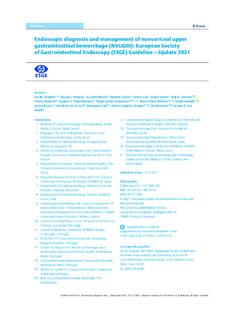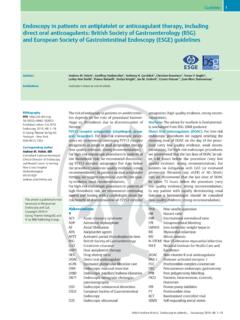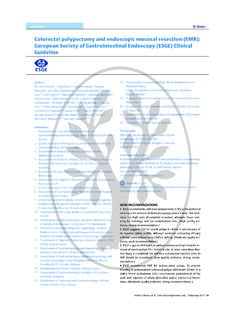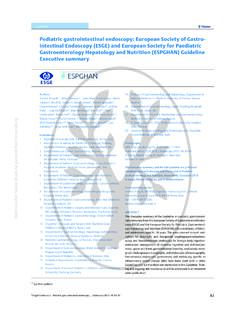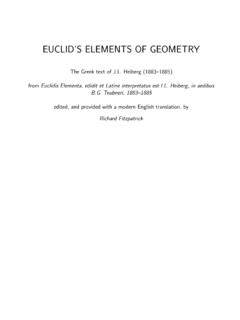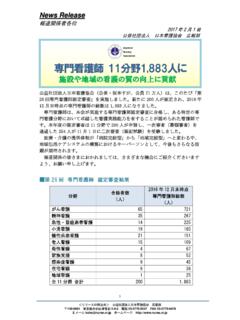Transcription of Guideline - esge.com
1 GuidelineManagement of epithelial precancerous conditions and lesions inthe stomach (MAPS II): European Society of GastrointestinalEndoscopy (ESGE), EuropeanHelicobacterand Microbiota StudyGroup (EHMSG), European Society of Pathology (ESP), andSociedade Portuguesa de Endoscopia Digestiva (SPED) guidelineupdate 2019 AuthorsPedro Pimentel-Nunes1,2,3, Diogo Lib nio1,2, Ricardo Marcos-Pinto2,4, Miguel Areia2,5,MarcisLeja6,Gianluca Esposito7, Monica Garrido4, Ilze Kikuste6, Francis Megraud8, Tamara Matysiak-Budnik9, Bruno Annibale7,Jean-Marc Dumonceau10, Rita Barros11,12,Jean-Fran oisFl jou13, F tima Carneiro11,12,14, Jeanin E. van Hooft15,Ernst J. Kuipers16, Mario Dinis-Ribeiro1,2 Institutions1 Gastroenterology Department, Portuguese OncologyInstitute of Porto, Portugal2 Center for Research in Health Technologies andInformation Systems (CINTESIS), Faculty of Medicine,Porto, Portugal3 Surgery and Physiology Department, Faculty ofMedicine of the University of Porto, Porto, Portugal,4 Department of Gastroenterology, Porto UniversityHospital Centre, Institute of Biomedical Sciences,University of Porto (ICBAS/UP)
2 , Portugal5 Gastroenterology Department, Portuguese OncologyInstitute of Coimbra, Portugal6 Institute of Clinical and Preventive Medicine, Universityof Latvia, Digestive Diseases Center, GASTRO, Riga,Latvia7 Department of Medicine, Surgery and TranslationalMedicine University Hospital Sant Andrea, UniversitySapienza Roma, Rome, Italy8 INSERM U1053, Universit de Bordeaux and CHUP ellegrin, Laboratoire de Bacteriologie, Bordeaux,France9 IMAD, Hepato-Gastroenterology and DigestiveOncology, CHU de Nantes, University of Nantes, France10 Gedyt Endoscopy Center, Buenos Aires, Argentina11 Institute of Molecular Pathology and Immunology atthe University of Porto (Ipatimup), Porto, Portugal12 Instituto de Investiga o e Inova o em Sa de (i3S),University of Porto, Porto, Portugal13 Service d Anatomie Pathologique, H pital Saint-Antoine, AP-HP, Facult de M decine SorbonneUniversit , Paris, France14 Pathology Department, Centro Hospitalar de S o Jo oand Faculty of Medicine, Porto, Portugal15 Department of Gastroenterology and Hepatology,AmsterdamUMC,UniversityofAmst erdam,TheNetherlands16 Department of Gastroenterology and Hepatology,Erasmus MC University Medical Center, Rotterdam,The online: | Endoscopy 2019; 51: 365 388 Georg Thieme Verlag KG Stuttgart New YorkISSN 0013-726 XCorresponding authorPedro Pimentel-Nunes, MD PhD, GastroenterologyDepartment, Portuguese Oncology Institute of Porto, RuaDr.
3 Bernardino de Almeida, 4200-072 Porto, PortugalFax: materialOnline content viewable at: Pedro et al. MAPS II .. Endoscopy 2019; 511 IntroductionGastric cancer is still a major world problem, ranking fifth forincidence and third for cancer-related mortality worldwide inthe latest published global cancer statistics [1]. Even thoughearly recognition and treatment is possible, most cases are di-agnosed at a late stage and thus most patients with a diagnosisof gastric cancer die of the disease [1]. Screening and surveil-lance of people at risk may decrease gastric cancer mortalityby allowing early detection and treatment, often by endoscopyinstead of more invasive surgery, and have therefore been re-commended [2,3].In 2012, the European Society of Gastrointestinal Endoscopy(ESGE), the Sociedade Portuguesa de Endoscopia Digestiva(SPED), the European Helicobacter and Microbiota Study Group(EHMSG), and the European Society of Pathology (ESP) pro-duced the first international Guideline on the management ofprecancerous conditions and lesions in the stomach (MAPS) [4,5].
4 Its recommendations were then presented in various coun-tries, ,theMAPS Guideline was incorporated into ESGE guidelines on qual-ity parameters for upper gastrointestinal (GI) endoscopy [6].This document aims to update the first MAPS Guideline (re-ferred to here as MAPS I) and to summarize current evidence onthe management of patients with precancerous conditions andlesions, focusing on the evidence published after RECOMMENDATIONSP atients with chronic atrophic gastritis or intestinal meta-plasia (IM) are at risk for gastric adenocarcinoma. Thisunderscores the importance of diagnosis and risk stratifica-tion for these patients. High definition endoscopy withchromoendoscopy (CE) is better than high definitionwhite-light endoscopy alone for this purpose.
5 Virtual CEcan guide biopsies for staging atrophic and metaplasticchanges and can target neoplastic lesions. Biopsies shouldbe taken from at least two topographic sites (antrum andcorpus) and labelled in two separate vials. For patientswith mild to moderate atrophy restricted to the antrumthere is no evidence to recommend surveillance. In patientswith IM at a single location but with a family history of gas-tric cancer, incomplete IM, or persistentHelicobacter pylorigastritis, endoscopic surveillance with CE and guided biop-sies may be considered in 3 years. Patients with advancedstages of atrophic gastritis should be followed up with ahigh quality endoscopy every 3 years. In patients with dys-plasia, in the absence of an endoscopically defined lesion,immediate high quality endoscopic reassessment with CEis recommended.
6 Patients with an endoscopically visible le-sion harboring low or high grade dysplasia or carcinomashould undergo staging and pylorieradicationheals nonatrophic chronic gastritis, may lead to regressionof atrophic gastritis, and reduces the risk of gastric cancerin patients with these conditions, and it is pylorieradication is also recommended for patients withneoplasia after endoscopic therapy. In intermediate to highrisk regions, identification and surveillance of patients withprecancerous gastric conditions is AND SCOPEThis Guideline is an official statement of the EuropeanSociety of Gastrointestinal Endoscopy (ESGE), the Euro-pean Helicobacter and Microbiota Study Group (EHMSG),the European Society of Pathology (ESP), and the Socie-dade Portuguesa de Endoscopia Digestiva (SPED).
7 Basedon new evidence, it makes recommendations on the diag-nostic assessment and management of individuals withatrophic gastritis, intestinal metaplasia and dysplasia ofthe stomach, updating the 2012 MAPS of Guidelines for Research andEvaluationAUCarea under the curveCEchromoendoscopyCIconfidence intervalCOXcyclo-oxygenaseEGCearly gastric cancerEHMSGE uropeanHelicobacterand Microbiota StudyGroupESDendoscopic submucosal dissectionESGEE uropean Society of GastrointestinalEndoscopyESPE uropean Society of PathologyGIgastrointestinalGRADEG rading of Recommendations Assessment,Development, and EvaluationHD-WLEhigh definition white-light endoscopyHGDhigh grade dysplasiaHRhazard ratioIMintestinal metaplasiaLGDlow grade dysplasiaMAPSM anagement of precancerous conditions andlesions in stomachNBInarrow-band imagingNSAID nonsteroidal anti-inflammatory drugOLGAO perative Link on Gastritis AssessmentOLGIMO perative Link on Gastritis Assessment basedon Intestinal MetaplasiaORodds ratioRCTrandomized controlled trialRRrelative riskSIRstandardized incidence ratioSPEDS ociedade Portuguesa de EndoscopiaDigestivaGuidelinePimentel-Nun es Pedro et al.
8 MAPS II .. Endoscopy 2019; 51 ScopeManagement (diagnostic assessment, treatment, and surveil-lance) of individuals with atrophic gastritis, intestinal metapla-sia, and dysplasia of the MethodsThese recommendations were developed according to the Ap-praisal of Guidelines for Research and Evaluation (AGREE) pro-cess for the development of clinical practice guidelines [7]. InOctober 2016, on behalf of ESGE, EHMSG, ESP, and SPED, thecoordinators of the previous 2012 Guideline (MAPS I) assem-bled a panel of European gastroenterologists and pathologistsin order to produce an updated Guideline , MAPS groups were set up to cover the following topics:(1) Definitions and prevalence; (2) Endoscopic diagnosis;(3) Biopsies and histology; (4) Noninvasive assessment; (5) Fol-low-up; (6)Helicobacter pyloritreatment; (7) Other therapies;(8) Management; and (9) Cost-effectiveness.
9 (See online-onlySupplementary material.)The evidence-based Delphi process was applied to developconsensus statements. First,key questions were agreed andstatements were proposed by the MAPS II coordinators ( ), considering previous MAPS I statements and po-tential changes to previous recommendations. Each workinggroup considered their statements, and changed these accord-ing to evidence if necessary. A literature search was done usingPubMed (until March 2018) with a focus on articles publishedafter the MAPS I literature search (November 2010). Each work-ing group rated the quality level of the available evidence andthe strength of recommendations using the Grading of Recom-mendations Assessment, Development, and Evaluation(GRADE) process [8,9].
10 The MAPS II coordinators evaluatedand grouped each statement and evidence in a single docu-ment with all the necessary bibliography. This document wasthen sent to every participant and statements were votedupon online. At this stage, changes were made if necessary andstatements with less than 75% agreement were excluded. Afinal version with the consensus recommendations ( Table1)wassent to and approved by every author. Finally, the manu-script was reviewed by two members of the ESGE GoverningBoard and sent for further comments to the National Societiesand Individual Members. Suggestions were considered, andafter agreement on a final version the manuscript was submit-ted for Definitions and prevention Gastric carcinogenesisIntestinal-type gastric adenocarcinoma represents the finaloutcome of the inflammation atrophy metaplasia dysplasia carcinoma sequence, known as the Correa cascade [10 14].


